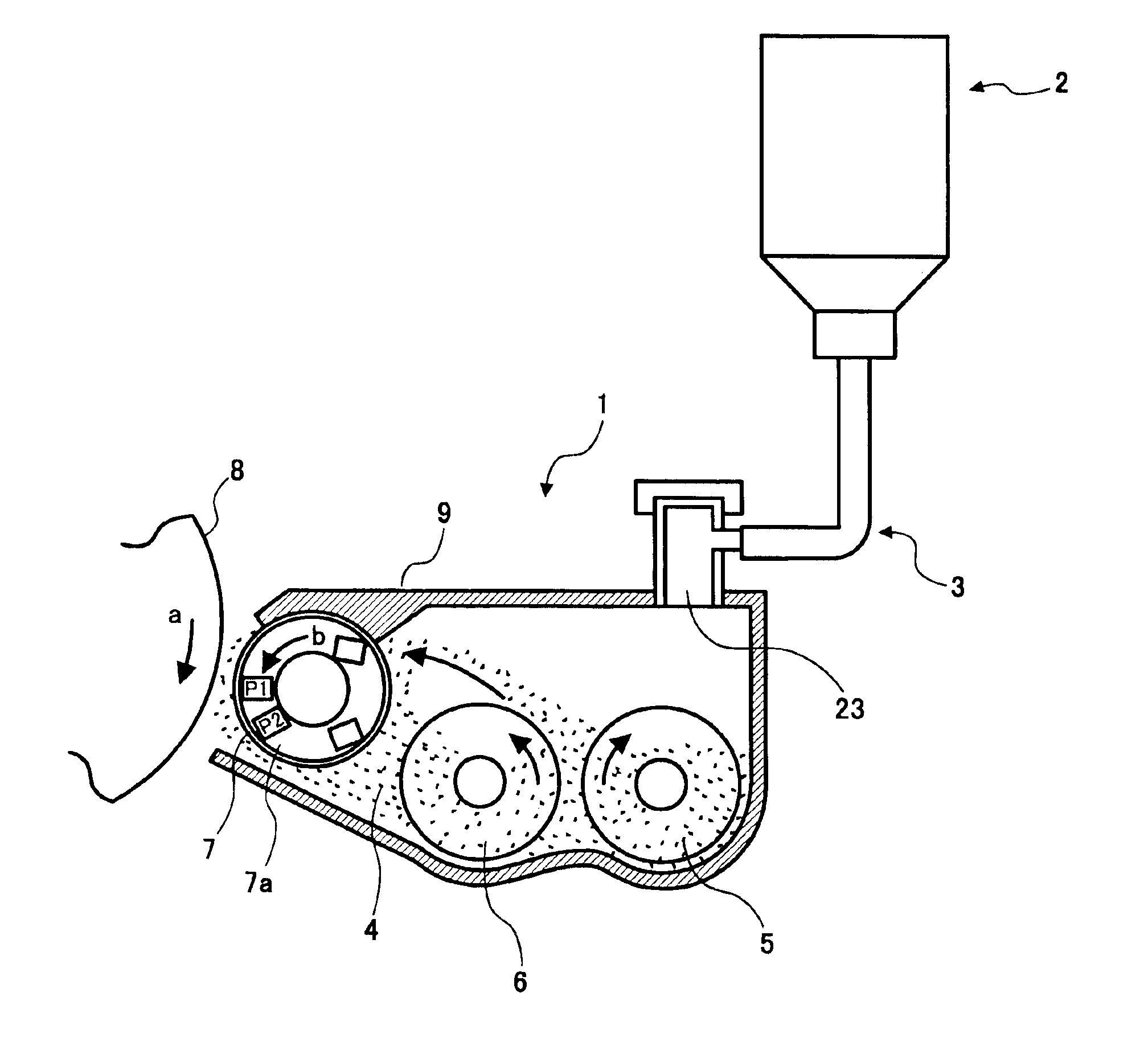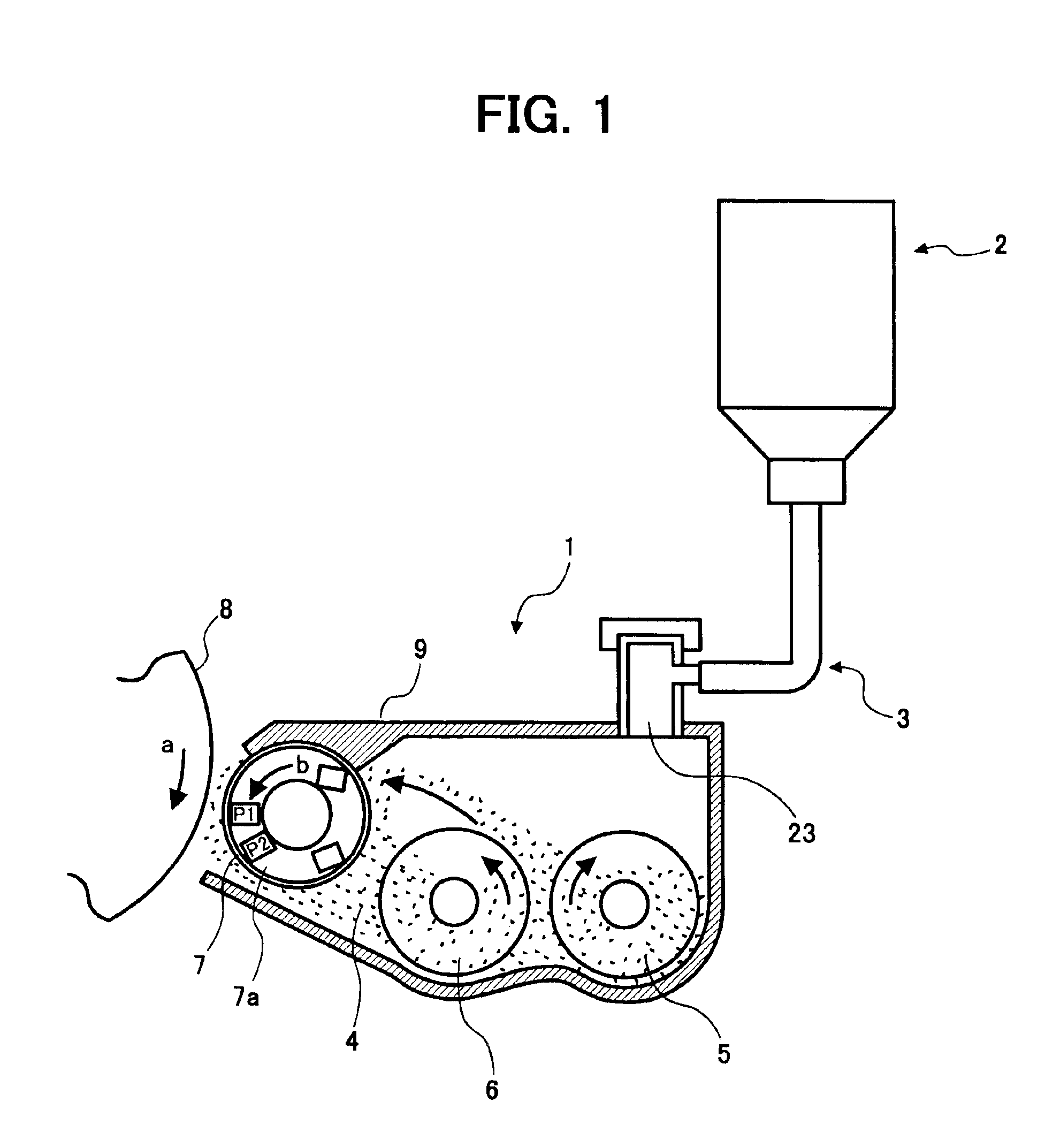Developing method and apparatus using two-ingredient developer with prescribed coating of particles and resin
a technology of developer and developer, which is applied in the field of developing methods using two-ingredient developer and image forming apparatus, can solve the problems of inability to stably charge developer, deterioration of carrier grains, and varying ratios of toner and carrier mixture, and achieve the effect of high image quality
- Summary
- Abstract
- Description
- Claims
- Application Information
AI Technical Summary
Benefits of technology
Problems solved by technology
Method used
Image
Examples
first embodiment
[0056]A first embodiment of the present invention mainly addresses to the problem (1) of the conventional technologies stated earlier. The illustrative embodiment is applied to an image forming apparatus of the type including a photoconductive drum or image carrier and a charger, an exposing unit, a developing unit, an image transferring unit and a cleaning unit sequentially arranged around the drum. The image forming apparatus additionally includes a sheet feeding device for feeding a sheet or recording medium from a sheet tray, and a fixing unit for fixing a toner image transferred to the sheet after the sheet has been separated from the drum.
[0057]In operation, while the drum is in rotation, the charger uniformly charges the surface of the drum. The exposing unit scans the charged surface of the drum with, e.g., a laser beam in accordance with image data to thereby form a latent image. The developing unit deposits charged toner on the latent image for thereby producing a correspo...
experiment 6
[0088]Use was made of the magnetic carrier grains of Example 1 and Comparative Example 1 while the diameter of the sleeve 7 was varied to 12 mm, 15 mm, 25 mm, 35 mm and 40 mm. Only the developing unit was idled for a period of time corresponding to 60,000 prints of size A4 in order to estimate the decrease in the amount of deposition. FIG. 7 shows the result of Experiment 6. As shown, when the carrier grains of Example 1 were used, the sleeve diameter of 12 mm caused the amount of deposition to decrease and caused irregular deposition and carrier deposition to occur as well. The sleeve diameter of 15 mm or above did not cause the amount of deposition to decrease below the allowable level or did not bring about irregular deposition or carrier deposition. The magnetic carriers of Comparative Example 1 caused the amount of deposition to decrease when the sleeve diameter was 12 mm and caused irregular deposition and carrier deposition to occur as well. Although irregular deposition and ...
experiment 7
[0090]Use was made of the magnetic carrier grains of Example 1 and Comparative Example 1 while the linear velocity of the sleeve 7 was varied to 130 mm / sec, 150 mm / sec, 300 mm / sec, 700 mm / sec and 750 mm / sec. As for the other conditions, Experiment 7 was conducted in the same manner as Example 1 to estimate the decrease in the amount of deposition. As shown in FIG. 8, the amount of deposition of the carrier grains of Example 1 did not decrease below 30% when the linear velocity was between 130 mm / sec and 700 mm / sec. However, when the linear velocity was 750 mm / sec, the stress acting on the developer was so heavy, the amount of deposition decreased by more than 30%. On the other hand, in Comparative Example 1, the amount of deposition decreased by more than 30% when the linear velocity was between 150 mm / sec and 750 mm / sec due to heavy stress; the decrease could not be reduced unless the linear velocity was as low as 130 mm / sec or below.
[0091]In the illustrative embodiment, the doctor...
PUM
 Login to View More
Login to View More Abstract
Description
Claims
Application Information
 Login to View More
Login to View More - R&D
- Intellectual Property
- Life Sciences
- Materials
- Tech Scout
- Unparalleled Data Quality
- Higher Quality Content
- 60% Fewer Hallucinations
Browse by: Latest US Patents, China's latest patents, Technical Efficacy Thesaurus, Application Domain, Technology Topic, Popular Technical Reports.
© 2025 PatSnap. All rights reserved.Legal|Privacy policy|Modern Slavery Act Transparency Statement|Sitemap|About US| Contact US: help@patsnap.com



